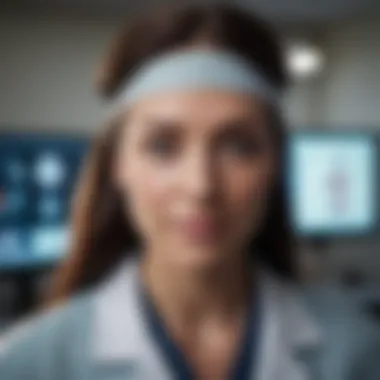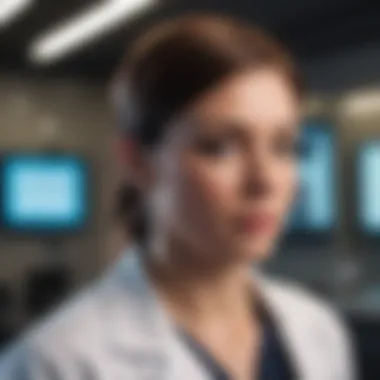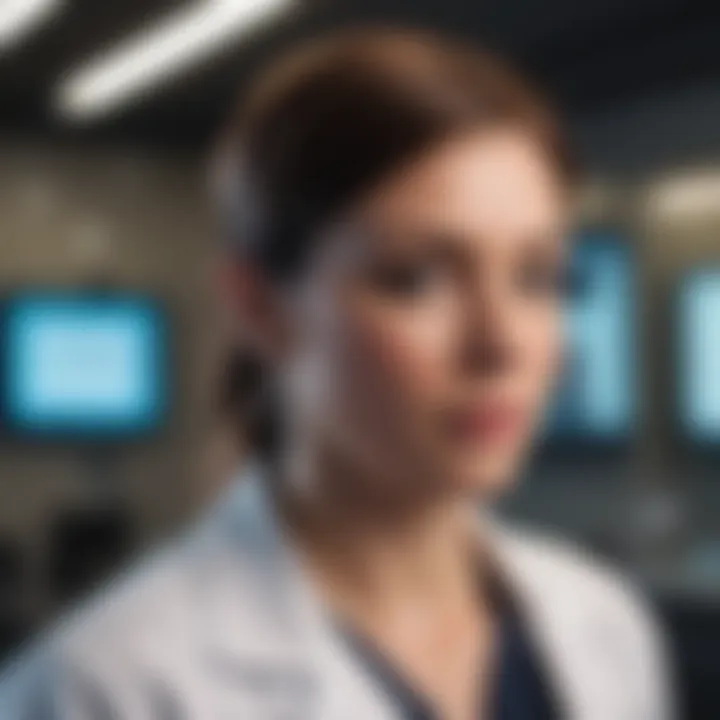Exploring Remote Medical Diagnostics: Advances & Impact


Intro
The expansion of remote medical diagnostics marks a noteworthy evolution in healthcare, bridging geographical gaps and making medical expertise more accessible. As technology continues to advance, telemedicine stands at the forefront of this transformation, providing tools that allow healthcare professionals to evaluate patients without physical presence.
This development not only enhances patient experience but also presents a more efficient model for healthcare delivery. Moreover, artificial intelligence plays a crucial role in analyzing data gathered remotely, enabling quicker decision-making and improved diagnostic accuracy.
Research Overview
Summary of Key Findings
Research indicates that remote medical diagnostics are reshaping the landscape of patient care. Telemedicine platforms are becoming increasingly utilized, allowing providers to conduct medical consultations through video calls or mobile applications. These platforms often come with integrated diagnostic tools, which assist in symptom assessment and monitoring chronic conditions.
A recent study highlights that patients engaging with remote diagnostics reported higher satisfaction rates compared to traditional in-person visits. This change can be attributed to convenience and the perceived quality of care received.
Relevance to Current Scientific Discussions
The integration of artificial intelligence and machine learning algorithms into diagnostic processes is a significant aspect of current research. These technologies are proving valuable for interpreting vast amounts of data efficiently, which is critical in urgent healthcare scenarios. Furthermore, regulatory considerations and privacy issues surrounding patient data are subjects of pressing discussion among stakeholders.
Methodology
Research Design and Approach
The research approach undertaken involves a mixed-method strategy. It combines qualitative and quantitative data to provide a comprehensive view of remote diagnostics’ impact. Surveys collected from both patients and healthcare providers reveal their experiences and challenges faced during remote consultations.
Existing literature on telemedicine, AI applications, and patient care frameworks forms the basis of secondary data analysis. This helps to contextualize findings within the broader healthcare landscape.
Data Collection and Analysis Techniques
Data was collected using online surveys and interviews to gather personal insights from healthcare professionals. Statistical analysis tools were employed to determine satisfaction levels and identify common barriers to effective remote diagnostics.
- Surveys: Distributed to a diverse sample of patients and providers.
- Interviews: Conducted with healthcare leaders to gain expert opinions.
- Literature Review: Integrated findings from recent studies on telemedicine and AI.
"The transition to remote medical diagnostics is not merely a trend; it’s a fundamental change in how healthcare could be delivered in the future."
This statement encapsulates the essence of the shifts being observed in this field.
Prelims to Remote Medical Diagnostics
Remote medical diagnostics have emerged as a vital component of contemporary healthcare systems. They allow for the timely evaluation of patient health without the need for physical presence. This innovation addresses several challenges faced by traditional medical practices, particularly in rural or underserved areas. It improves patient access to care, optimizes resource allocation in healthcare facilities, and can lead to better health outcomes through timely interventions.
Definition and Overview
Remote medical diagnostics refer to the practice of evaluating patients' health using technology, allowing healthcare professionals to gather diagnostic information from a distance. This encompasses various methods including telehealth consultations, remote monitoring systems, and mobile health applications. The primary aim is to deliver patient-centered care that is efficient and effective, while minimizing the need for in-person visits.
These systems utilize a blend of hardware and software technologies that facilitate data sharing between patients and healthcare providers. Key technologies include telemedicine platforms, wearable health devices, and mobile applications designed for health monitoring.
Historical Context
The concept of remote medical diagnostics is not new. However, its implementation has changed significantly over time. Early examples date back to the invention of the telephone, when doctors would offer consultation advice over the phone. This evolved with advancements in technology.
In the late twentieth century, the introduction of telemedicine began to take shape. Early implementations often faced challenges, including limited technology and regulatory constraints. With the advent of internet connectivity and mobile technology in the twenty-first century, remote diagnostics gained momentum. A notable milestone occurred during the COVID-19 pandemic when the necessity of remote healthcare became undeniable.


Recent advancements in artificial intelligence and machine learning have further propelled this field, offering sophisticated diagnostic tools that enhance the accuracy and efficiency of remote assessments.
"The evolution of remote diagnostics is a testament to the potential of technology in reshaping healthcare delivery, making it more accessible and efficient for patients worldwide."
Technological Innovations in Remote Diagnostics
Technological innovations in remote diagnostics have transformed how healthcare is delivered. The integration of these advanced technologies is essential for improving patient care and enhancing healthcare systems. As we explore this topic, we will discuss telemedicine platforms, wearable health devices, and artificial intelligence applications. Each of these elements contributes significantly to the effectiveness and efficiency of remote diagnostics, providing tools for timely patient assessments, data analysis, and improving healthcare accessibility.
Telemedicine Platforms
Telemedicine platforms are at the forefront of remote medical diagnostics. These systems facilitate virtual appointments between patients and healthcare providers, reducing the need for in-person visits. The importance of telemedicine can be summed up in a few critical points:
- Accessibility: Patients in remote areas can access healthcare services without long travel times.
- Convenience: Patients can consult with healthcare professionals from their homes, improving patient compliance and satisfaction.
- Continuity of Care: Telemedicine enables follow-ups and check-ups to occur regularly and easily, ensuring ongoing patient engagement.
Furthermore, telemedicine platforms are evolving with functionalities such as online appointment scheduling, digital health records, and remote prescription services. By leveraging these capabilities, healthcare providers can offer comprehensive care remotely, fostering a seamless experience for patients.
Wearable Health Devices
Wearable health devices are an integral part of the remote diagnostics landscape. These devices allow for continuous monitoring of a patient's health metrics, providing real-time data that healthcare providers can analyze. Key points include:
- Data Collection: Devices such as smartwatches and fitness trackers can monitor heart rate, blood pressure, and activity levels, collecting crucial health data.
- Patient Empowerment: Patients can take an active role in managing their health by tracking their metrics daily.
- Preventive Care: Continuous monitoring helps in early detection of potential health issues before they escalate.
The integration of wearables with telemedicine platforms further enhances their utility, as real-time data can be shared directly with healthcare professionals during teleconsultations. This synergy enables more informed clinical decisions, improving patient care outcomes.
Artificial Intelligence Applications
Artificial Intelligence (AI) is revolutionizing the field of remote medical diagnostics by enhancing the capabilities of existing technologies. Key applications include:
- Image Analysis: AI can analyze medical images such as X-rays and MRIs with remarkable accuracy, assisting radiologists in diagnosing conditions early.
- Predictive Analytics: By analyzing vast amounts of patient data, AI can predict potential health risks and suggest preventive measures.
- Natural Language Processing: This allows healthcare providers to extract meaningful insights from unstructured data, improving clinical workflows.
The incorporation of AI in remote diagnostics does pose challenges, such as data quality and ethics. Nevertheless, its benefits in enhancing diagnostic accuracy and personalized patient care are notable.
"Technological innovations such as telemedicine and AI have potential to redefine patient care, making healthcare more accessible and efficient."
Benefits of Remote Medical Diagnostics
Remote medical diagnostics have ushered in a new era in healthcare by providing various advantages that improve not only patient care but also the overall efficiency of healthcare systems. These benefits range from better accessibility and reduced costs to improved patient outcomes. Understanding these advantages is crucial for stakeholders in the healthcare sector as they navigate the implications of distant diagnostics.
Enhanced Access to Care
One of the most significant benefits of remote medical diagnostics is the enhanced access to healthcare services. Patients in rural or underserved regions often face challenges in accessing timely medical consultation. This limitation can lead to delayed diagnoses and treatment. With remote diagnostics, patients can consult healthcare professionals from their homes.
Telehealth platforms and mobile apps enable consultations through video calls or chats. This means that individuals who reside far from medical facilities can receive expert advice without the need for long travel. It particularly helps those with mobility issues or chronic illnesses.
Additionally, remote diagnostics foster inclusivity for various patient demographics, such as the elderly and disabled. They can manage their health conditions without the stress of travel. This ensures that everyone has equitable access to necessary healthcare, significantly bridging the gap in health disparities.
Cost-Effectiveness


Cost-effectiveness is another critical advantage of remote medical diagnostics. Both patients and healthcare systems can save substantial amounts through reduced costs associated with in-person visits. For patients, avoiding travel expenses and minimizing time off work represent tangible financial relief. Moreover, telehealth appointments often come with lower healthcare fees compared to traditional consultations.
From the perspective of healthcare providers, remote diagnostics reduce overhead costs associated with maintaining physical office spaces. Facilities can allocate resources more effectively, optimizing staff's time and minimizing wasted equipment. This efficiency can lead to overall savings for the healthcare system, enabling providers to redirect funds toward improving patient services.
Improved Patient Outcomes
Improved patient outcomes are a significant focus in healthcare. Remote diagnostics enable early detection of various medical conditions, which is essential for effective treatment. Regular monitoring and timely follow-ups can lead to better management of chronic illnesses.
Through the integration of wearable health devices and telemedicine, healthcare professionals can continuously monitor patients' health metrics. This real-time data allows for quick intervention if any red flags arise. Consequently, patients receive personalized care tailored to their needs, fostering better adherence to treatment plans and ultimately resulting in healthier populations.
"Remote diagnostics empower patients and providers alike; they ensure that healthcare is both accessible and effective."
Challenges in Implementing Remote Diagnostics
The implementation of remote medical diagnostics brings many benefits, yet it does not come without its challenges. Understanding these challenges is essential for anyone involved in the healthcare sector, particularly as these technologies become more prevalent. Addressing issues such as data privacy, regulatory compliance, and technological barriers is crucial for the successful integration of remote diagnostics into mainstream healthcare practice.
Data Privacy and Security
The first major challenge to consider is data privacy and security. With the digital transformation of healthcare, sensitive patient information is often transmitted over the internet. This makes it vulnerable to breaches and unauthorized access. Cybersecurity threats pose significant risks, especially given recent data breaches in various sectors.
Healthcare providers must adopt robust security measures to protect patient data. This includes encryption protocols, secure databases, and continuous monitoring of network activity. However, while implementing these measures, healthcare professionals must also balance accessibility. Patients need convenient access to their health data without facing significant barriers that could deter them from utilizing remote services.
Regulatory Hurdles
Navigating the regulatory landscape is another challenge that hampers the growth of remote medical diagnostics. Different countries have various regulations regarding telehealth practices and patient data protection. For instance, the Health Insurance Portability and Accountability Act (HIPAA) in the United States sets strict rules for maintaining patient confidentiality.
These regulations can sometimes create a complex web, making it difficult for healthcare providers to implement remote diagnostics effectively. Compliance requires understanding local laws, which can vary widely and lead to increased administrative costs. To adapt, telehealth services should not only stay informed about the legal framework that governs their operations but also advocate for more streamlined regulations to enhance their efficacy.
Technological Barriers
Lastly, technological barriers present significant obstacles in the realm of remote diagnostics. These include issues such as inconsistent internet connectivity, lack of access to the latest technologies, and the digital divide between urban and rural areas.
Patients in rural areas might struggle with limited broadband access, leading to ineffective remote consultations. Additionally, health providers need to invest in training staff to familiarize them with new tools and platforms. Without adequate training, the risk of error increases, which could ultimately impact patient care.
Furthermore, there is also the question of device compatibility and interoperability between systems. If different diagnostic tools cannot communicate, it hampers the efficiency of patient care.
"Understanding and addressing the challenges in remote diagnostics can pave the way for enhancing patient care while ensuring compliance with necessary regulations."
The future of remote medical diagnostics hinges on the healthcare sector’s ability to recognize and mitigate these challenges. The complexity of data privacy, regulatory compliance, and technology utilization underscores the need for a collaborative approach. By leveraging the collective insights from the field, we can look forward to a more integrated, effective, and secure remote healthcare system.
Case Studies in Remote Medical Diagnostics
Case studies serve as a vital component in understanding the practical implications of remote medical diagnostics. They showcase real-world scenarios where these technologies can lead to significant improvements in patient care, efficiency, and overall healthcare delivery. By analyzing the successes and challenges faced in various instances, we gain insights that can guide future implementations and improvements.
A comprehensive look at these case studies highlights the adaptability of telemedicine and AI technologies. These fields offer unique solutions tailored to the needs of diverse patient populations. Moreover, they reveal important lessons regarding best practices and potential pitfalls in this relatively new landscape. The case studies also help validate the effectiveness of remote diagnostics, demonstrating their tangible benefits in real-life situations.
Telehealth Success Stories


Many telehealth initiatives have proven to be successful, particularly during the COVID-19 pandemic. For instance, the implementation of telehealth services in communities with limited access to healthcare has shown remarkable outcomes. In one study conducted in rural areas, patients who utilized telehealth reported improved management of chronic conditions such as diabetes and hypertension. This form of remote monitoring allowed healthcare providers to adjust treatment plans in real time, greatly enhancing patient adherence and outcomes.
Additionally, a notable success story involves the use of telemedicine in mental health care. Platforms like Teladoc have facilitated virtual consultations, making psychological support more accessible to individuals who may otherwise struggle to seek help. Patients reported higher satisfaction levels due to the convenience and anonymity of remote sessions, ultimately leading to better mental health management and reduced stigma associated with seeking treatment.
AI in Diagnostic Imaging
The integration of artificial intelligence in diagnostic imaging has marked a significant advancement in remote medical diagnostics. AI algorithms can analyze medical images with impressive speed and accuracy. For example, studies have shown that AI systems, such as Google's DeepMind, have outperformed human radiologists in identifying certain conditions, including breast cancer in mammograms.
One study illustrated how implementing AI in radiological practices improved the detection rate of diseases while reducing the workload for radiologists. By automating initial readings, healthcare professionals could focus on complex cases that required their expertise, ultimately improving patient care quality.
Moreover, AI technologies also assist radiologists by highlighting areas of concern, which allows for quicker diagnosis and treatment. This efficiency matters significantly when every second can impact patient outcomes. As advancements continue, the potential for AI to transform diagnostic imaging appears immense.
Future Trends in Remote Medical Diagnostics
The realm of remote medical diagnostics is continuously evolving, driven by innovation and emerging technologies. Understanding future trends is essential as it will impact healthcare delivery and patient interaction. The integration of advanced technologies will enhance the quality of care and promote proactive health management.
Integration with IoT
The Internet of Things (IoT) is poised to revolutionize the way remote medical diagnostics function. With interconnected devices, healthcare providers can gather real-time data from patients, leading to a more holistic understanding of their health status.
- Smart wearables can monitor vital signs such as heart rate, blood pressure, and blood glucose levels, transmitting data directly to healthcare professionals. This immediate access to patient information enables timely interventions, reducing emergency visits.
- Devices like smart inhalers or insulin pens are practical examples of how IoT is being utilized to monitor chronic conditions more effectively. These devices collect data on usage patterns and effectiveness, which are crucial for managing treatment plans.
"IoT is a game changer in remote medical diagnostics, as it allows for continuous monitoring and personalized care delivery."
Patients benefit from this integration, as it facilitates proactive health management and personalized treatment plans. Therefore, IoT-enhanced diagnostics will likely lead to better health outcomes.
Expansion of Remote Monitoring
Remote monitoring is expanding rapidly in the healthcare sector. This shift toward remote technologies improves patient engagement and allows for broader access to healthcare.
- Telemonitoring systems are already being widely adopted, particularly for managing chronic diseases. Conditions such as heart failure or diabetes require careful monitoring, which remote technologies can provide.
- The implementation of mobile health (mHealth) applications also supports this trend, enabling patients to track their health metrics and manage medications from their devices.
The expansion of remote monitoring leads to a shift in the traditional healthcare model.
- It encourages patients to take a more active role in their health management.
- It decreases hospital visits, helping healthcare facilities manage resources more efficiently.
Ending
In this article, we discussed how remote medical diagnostics are reshaping healthcare delivery. The significance of this topic cannot be overstated. As technology evolves, so does the need for efficient and effective patient assessment from a distance. Remote diagnostics not only enhance accessibility but also provide innovative solutions to longstanding issues within healthcare systems.
Recap of Key Points
Remote medical diagnostics have emerged as a critical innovation in healthcare. Several key points are worth highlighting:
- Technological Integration: The rise of telemedicine platforms and wearable health devices plays a crucial role in offering timely medical assessments.
- AI Applications: Artificial Intelligence has significantly enhanced diagnostic accuracy and has helped in predictive medication.
- Patient Access and Cost: Improved access to medical care, particularly in underserved areas, represents a direct benefit of remote medical diagnostics. Additionally, the cost-effectiveness of such solutions aids both patients and healthcare providers.
- Challenges: Issues like data privacy and regulatory hurdles continue to pose challenges. Addressing these obstacles is imperative for wider adoption of remote diagnostics.
The Future of Remote Medical Diagnostics
Looking ahead, remote medical diagnostics are set to evolve considerably. The integration of the Internet of Things (IoT) allows devices to communicate seamlessly. This capability can lead to better monitoring and real-time data collection.
- Expansion of Remote Monitoring: The future may also see an increase in remote patient monitoring. More individuals are likely to manage their health from home, connected through various devices that relay important health data to medical professionals.
- Enhanced Personalization: Personalization will be a hallmark of future developments. Advanced data analytics can tailor diagnoses and treatment plans specifically for individual needs.
- Continuous Learning: As machine learning algorithms develop, they will enhance diagnostic capabilities by learning from vast pools of health data.
The revolution in healthcare is just beginning. Remote medical diagnostics are poised to change how patients receive treatment and how healthcare professionals provide care.



